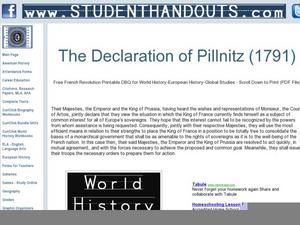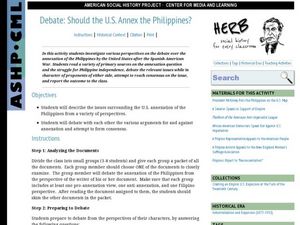University of Chicago
Using Artifacts for Clues About Identity
Learn about the ancient Near East through a close examination of ancient artifacts. Lead your class into analysis by first observing an artifact as a class. Pupils can then work in pairs to analyze the other artifacts and compile a list...
Student Handouts
The Cold War: The Truman Doctrine of 1947
What was the Truman administration's position on foreign policy during the Cold War? Class members respond to an excerpt from President Harry S. Truman's "Truman Doctrine" with three questions in the space provided.
Center for Civic Education
The Power of Nonviolence: What Is Nonviolence? What Does It Cost?
Your young learners will delve into the language of primary source documents in order to identify the characteristics, benefits, and costs of nonviolence. The lesson plan includes a mix of activities, including an anticipatory activity,...
K12 Reader
Finding Text Evidence: Frederick Douglass
After reading a very brief excerpt from Frederick Douglass' autobiography, learners cite textual evidence to support a main idea of the primary source about Douglass' humiliating experience with slavery. This is a brief exercise that...
mdk12.org
Primary Source Quadrant Cards
Young historians can use this simple graphic organizer to define primary source and list both examples and non-examples of the term. A similar resource can also be constructed for secondary sources!
Curated OER
Primary Source Analysis: 95 Theses Excerpts
By reviewing and analyzing these nine selected points from Martin Luther's 95 Theses, your young historians will discern the major tenets of the revolutionary challenge made against the Catholic Church in the seventeenth century. This is...
Curated OER
The Dust Bowl
Use this presentation to discuss the causes and effects of The Dust Bowl, or to establish a historical context for the book, The Grapes of Wrath. Found here are images, eye-witness quotes, and some ideas as to the causes and effects of...
Curated OER
America: The Story of Us Episode 6: The Heartland
I love handouts that include reading passages and discussion questions.Here you will find two pages. Page one provides an informational reading passage and six discussion questions. Page two provides a three paragraph primary-source...
Curated OER
Exploring George Washington's Leadership
Learners examine primary documents to determine whether or not George Washington was an honest leader. In this presidential history instructional activity, students evaluate Washington's leadership prior to and during his presidency....
Curated OER
The New England Fishing Industry:Sea Changes in a Community
Explore New England's economic and cultural past and possible issues New Englanders will face in the future. Middle and high schoolers research the fishing industry and the need for regulation. They analyze the topography of New England...
Curated OER
World War II
Almost every big city has a war memorial, and many have memorials specific to WWII. This is a preparatory lesson for learners going on a trip to visit a local war memorial site. They are introduced to WWII through a simple time line of...
Curated OER
Teacher Notes
Gathering information, distinguishing between arguments, preparing an oral presentation; these skills are fostered as 10th graders explore aspects of global trade and politics. They use the Internet to gather information about NATO, The...
Curated OER
Little House in the Census: Almanzo and Laura Ingalls Wilder
How would you use census data from 1880-1900? Here are a set of ways you can incorporate the book Little House on the Prairie and US census data from that time period. Learners will research the validity or the book based on factual...
Curated OER
Royal Proclamation on Education: King Chulalongkorn of Siam
How much did the King of Siam value education? Why did he believe haste was important? How do his views compare with modern views of education? These are the questions your class will answer after reading an excerpt from the "Royal...
Curated OER
French Revolution: The Declaration of Pillnitz
Answering document-based questions increases critical analysis and comprehension skills. The class reads a passage from The Declaration of Pillnitz then answers three critical thinking questions.
Curated OER
Applying KWL Guides to Sources with Elementary Students
What is a KWL chart? Here is a well thought-out lesson that has learners use KWL charts to gain historical perspective. Your class examines primary sources about historical events and identifies what they know, want to know, and,...
Curated OER
Using Primary Sources to Study the Holocaust
Engage your middle schoolers with Pastor Martin Niemoller's famous poem that begins, "First they came for the communists." Now that you have their attention, send learners to the various work stations you created to have them explore...
Curated OER
The Declaration of Pillnitz (1791)
Primary source documents are wonderful because they provide a real context for historical events. Here is an expert from The Declaration of Pillnitz (1791) for your readers to examine. They consider the passage then use it to answer...
Curated OER
Seneca Falls Convention: Declaration of Sentiments
The Seneca Falls Convention was an amazing outlet for the female voice during the time of women's suffrage. Learners will read a short, but powerful excerpt from the Declaration of Sentiment, as spoken at the convention. They'll answer...
Curated OER
Excerpt: Cecil Rhodes' Confession of Faith (1877)
Consider the words of Cecil Rhodes after reading this short excerpt from his publication, Confession of Faith. Upper graders read the excerpt then answer two questions analyzing the view of Africans toward his praise of British...
Curated OER
Imperialism: J.A. Hobson (1902)
J.A. Hobson was a popular writer, economist, and critic of Imperialism. Learners will read a short excerpt from one of his publications and answer two, two-part questions regarding his views on Western imperialism in Asia. Tip: Ask your...
Curated OER
Liberty Rhetoric
What is liberty rhetoric? Examine how people have used it in four different time periods and situations. High schoolers investigate original source documents and compare them with the Declaration of Independence to decide how liberty...
Curated OER
Debate: Should the U.S. Annex the Philippines?
Building an argument with supporting evidence is a vital skill. Learners engage in a debate over the annexation of the Philippines after the Spanish-American War. They take on the perspective of an individual from that time period,...
Curated OER
The Federalist Defense of Diversity: Extending the Sphere
How did early Americans ensure expansion while also securing the rights of citizens? Alexander Hamilton and James Madison, two of our early leaders, considered the problem of faction to be the "mortal disease" that created unstable...

























